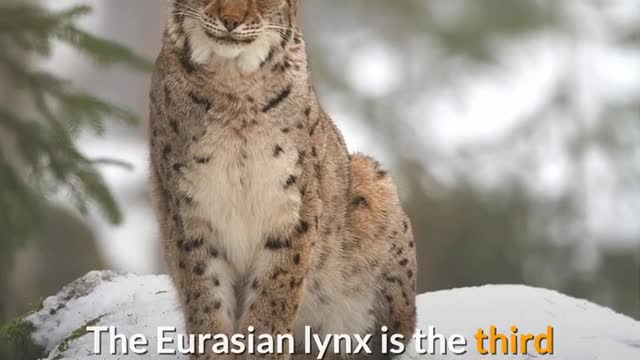Premium Only Content

Kinds of Red Lynx (lynx rufus)
A lynx is any of the four species (Canada lynx, Iberian lynx, Eurasian lynx, bobcat) within the medium-sized wild cat genus Lynx.
Lynx have a short tail, characteristic tufts of black hair on the tips of their ears, large, padded paws for walking on snow and long whiskers on the face. Under their neck they have a ruff which has black bars resembling a bow tie, although this is often not visible.
Body color varies from medium brown to goldish to beige-white, and is occasionally marked with dark brown spots, especially on the limbs. All species of lynx have white fur on their chests, bellies and on the insides of their legs, fur which is an extension of the chest and belly fur. The lynx's coloring, fur length and paw size vary according to the climate in their range. In the Southwestern United States, they are short-haired, dark in color and their paws are smaller and less padded. As climates get colder and more northerly, lynx have progressively thicker fur, lighter color, and their paws are larger and more padded to adapt to the snow. Their paws may be larger than a human hand or foot.
The smallest species are the bobcat and the Canada lynx, while the largest is the Eurasian lynx, with considerable variations within species.
The lynx is usually solitary, although a small group of lynx may travel and hunt together occasionally. Mating takes place in the late winter and once a year the female gives birth to between one and four kittens. The gestation time of the lynx is about 70 days. The young stay with the mother for one more winter, a total of around nine months, before moving out to live on their own as young adults. The lynx creates its den in crevices or under ledges. It feeds on a wide range of animals from white-tailed deer, reindeer, roe deer, small red deer, and chamois, to smaller, more usual prey: snowshoe hares, fish, foxes, sheep, squirrels, mice, turkeys and other birds, and goats. It also eats ptarmigans, voles, and grouse.
-
 0:32
0:32
BradMD
4 years ago2 Kinds of Economics
57 -
 0:59
0:59
brigond
3 years ago45s records all kinds
35 -
 52:01
52:01
Tucker Carlson
13 hours agoNew York Mayor Eric Adams Sounds a Lot Like a Trump Voter
205K171 -
 2:47:25
2:47:25
Right Side Broadcasting Network
12 hours agoLIVE REPLAY: President Donald J. Trump Holds First Press Briefing Since Inauguration - 1/21/25
242K211 -
 1:08:45
1:08:45
Man in America
11 hours agoTrump UNLEASHED! Dismantling the Deep State and Restoring America
44.8K44 -
 27:22
27:22
I_Came_With_Fire_Podcast
13 hours ago🔥SPECIAL RELEASE🔥 Inflation Reduction Act: American Seniors Get SLAMMED!!
47.7K10 -
 6:25:28
6:25:28
vivafrei
12 hours agoD.C. Gulag Jan. 6 Prisoners Release Watch!
221K108 -
 1:49:14
1:49:14
Redacted News
11 hours agoTrump is Back! Congress Uncovers New Biden Crimes One Day After He Leaves D.C. | Redacted
192K250 -
 2:09:53
2:09:53
Benny Johnson
11 hours ago🚨President Trump LIVE Right Now Making MASSIVE Announcement At White House News Conference
300K434 -
 2:04:10
2:04:10
Revenge of the Cis
12 hours agoEpisode 1433: Retribution
131K21